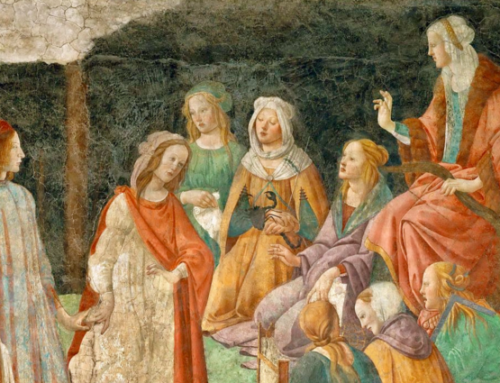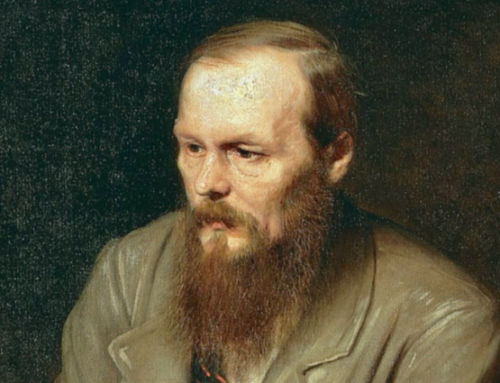David M. Steiner argues that American education needs a clear and organized focus on ethics, beauty, and academic rigor to achieve its core purpose of preparing students to seek what Aristotle called eudaimonia, or human flourishing.
A Nation at Thought: Restoring Wisdom in America’s Schools by David M. Steiner (224 pages, Rowman & Littlefield, 2023)
 How can America’s K-12 education system be saved? In A Nation at Thought: Restoring Wisdom in America’s Schools, David M. Steiner argues that American education needs a clear and organized focus on ethics, beauty, and academic rigor to achieve its core purpose of preparing students to seek what Aristotle called eudaimonia, or human flourishing.
How can America’s K-12 education system be saved? In A Nation at Thought: Restoring Wisdom in America’s Schools, David M. Steiner argues that American education needs a clear and organized focus on ethics, beauty, and academic rigor to achieve its core purpose of preparing students to seek what Aristotle called eudaimonia, or human flourishing.
Steiner’s critique of the education system is insightful and comprehensive. His call to reorient education around something akin to the classical Transcendentals – the True, the Good, and the Beautiful – is most welcome. But his prescription for what ails America’s schools is ultimately inadequate. Steiner’s recommendations are at once far too concrete to unite America’s many factions in a culture thoroughly soaked in materialism and moral relativism and also insufficiently rooted in a specific Judeo-Christian ethic to actually form students in the ethical life Steiner desires students to achieve.
Steiner, who is executive director of the Johns Hopkins Institute for Education Policy, devotes four of the five chapters in A Nation at Thought to diagnosing the fundamental problems with American education. His arguments are so insightful, those chapters alone make the book worthy of the reader’s consideration.
Education’s “Great Distractors”
Steiner begins by arguing, as have others, that American schools struggle for lack of clarity as to their core purpose. But as Steiner demonstrates, the education system is failing at virtually all its frequently competing goals. Whether it is promoting academic achievement, creating better opportunities for poor and minority students, preparing students for college and careers, or forming students for the responsibilities of citizenship in a democratic society, Steiner shows that our schools are failing to show meaningful progress in any area.
The reasons for these failures are due to what Steiner calls “the Great Distractors.”
“Despite the overwhelming importance of academic learning,” Steiner writes, “the majority of America’s teachers don’t rate the academic preparation of children as their highest aim.” Instead, they focus on the many faddish, ineffective, and poorly researched obsessions that seem to grip American education in repeating waves, including wispy ideas about teaching students “critical thinking” or “21st century” skills, social and emotional learning, and creativity.
Steiner shows that many of the stated goals of these various initiatives are far too vague to ever be accurately measured, and rather than representing some new, never-before-attempted element of education, are often just common-sense aspects of good teaching.
“Critical thinking,” “Grit,” “SEL,” “growth mindset” – when correctly understood as common-sense terms, have all been taught for a long time. It’s not that they had no place in schooling, just as it’s not that they have no place in schooling today. But they aren’t new, and the research support for putting them at the center of schooling is simply not there (p. 53).
“At its heart, the new learning isn’t new and it isn’t about learning,” Steiner writes. “Instead, it is a powerful and seductive effort to circumvent the tough challenge of providing effective, discipline-based academic instruction.”
What works in schools, and why we don’t do it
Steiner follows this assessment by arguing that we do, in fact, know what works in schools: strong, content-rich curricula, rigorous expectations for all students, good parental communication, robust teacher training, and an assessment system that closely aligns the curriculum with high-quality instruction, yielding actionable information about what students actually know and are able to do. The problem is that we just don’t consistently prioritize any of these things. The main reason is because our education system is thoroughly soaked in the anthropological and pedagogical assumptions of John Dewey and the “progressives.” Such assumptions include, among others, the following:
- Knowledge is constructed rather than transmitted, and therefore it is authoritarian and unjust to impose a body of knowledge on children who are natural learners and will, of their own accord, learn the things they need for their own flourishing, as each of them understands it.
- Such knowledge cannot be quantitatively measured, and therefore testing systems are naturally suspect.
- The teacher’s job is to nurture and encourage learning in students by offering them engaging opportunities to create meaning from their experiences, rather than to form students in particular knowledge, habits, or virtue.
Steiner shows the many practical ways in which such assumptions erode curriculum, assessment of student learning, and especially strong, teacher-centered instruction, and how low-income students often pay the greatest price:
It is striking that progressives, often grounding their arguments in appeals to freedom and a liberation from what they identified as the dead weight of intellectual authoritarianism, nevertheless created a model of education that condemned millions of the less privileged children to an inferior place in a fixed social-economic structure (p. 63).
Steiner sees some signs of progress toward more common-sense assumptions in education, including a renewed emphasis on content-rich curriculum, improved teacher training, and better methods of reading instruction, although he is justly critical that most state readings standards do little to distinguish what students at the high school level should be able to do that is more advanced than elementary students.
Ethics, beauty, and rigor
In the final chapter of A Nation at Thought, Steiner articulates his own vision for what should occupy the core focus of America’s schools. Steiner’s thesis is that the fundamental purpose of education should be nurturing the child’s capacity to think. While this might seem obvious, the preceding chapters show that this is not actually the enacted purpose of most American schools. For Steiner, thinking is the mechanism by which students learn to address the core question posed by Aristotle’s concept of eudaimonia, “What does it mean to have achieved a well-lived life?”
Steiner proposes that education should then be organized around three core concepts: ethics, beauty, and academic rigor, the combination of which is training for a life of wisdom.
For Steiner, ethics is about learning to reason one’s way to virtuous judgments rather than concluding what is right or wrong behavior based on the way it makes one feel. This happens by phronesis (another Aristotelian term), a kind of self-reflection on lived behaviors and their differing outcomes. Coupled with studying models of virtue from history and literature and pondering the ethical dimensions of great literary works, Steiner believes that students can arrive at hexis, a kind of conditioned disposition toward ethical decision making.
The second pillar of Steiner’s vision for education is aesthetics – an appreciation of beautiful things. Students should be taught how to recognize and appreciate genuine beauty in art, music, architecture, literature, and other forms of human expression. Steiner makes a nuanced argument based on the ideas of Immanuel Kant that there is, in fact, an objective quality of excellence that can be discerned in art. The fact that there is still much to debate about whether a given work of art realizes these criteria of beauty is what makes aesthetics a subject of profound and challenging thinking for students.
Finally, Steiner argues for a much more rigorous academic program for America’s schools: a richer, more detailed curriculum and more challenging learning tasks that ask students to perform at increasingly complex levels of thinking as they mature. For students to think, they must have something substantive to think about, and lessons that make them do so at a profound level of reflection. A renewed focus on academic rigor offers the necessary content for students to think ethically and aesthetically.
Can public schools embrace the True, the Good, and the Beautiful?
 There is much to admire in David M. Steiner’s prescription for American education. Most of his platform already constitutes the focus of America’s revival of K-12 classical education, a phenomenon that is almost entirely taking place in faith-based private schools and public charter schools.
There is much to admire in David M. Steiner’s prescription for American education. Most of his platform already constitutes the focus of America’s revival of K-12 classical education, a phenomenon that is almost entirely taking place in faith-based private schools and public charter schools.
Steiner, however, seems most interested in the implications of teaching for wisdom in traditional public schools, and believes his agenda is appropriate for the kind of diverse, multicultural constituents served by these secular institutions. “The elements [of my proposal] are meant to inclusive, acceptable to those whose politics or beliefs would otherwise divide them,” Steiner writes.
It is not clear, however, that this is the case. As much as we should hope that public education in America would embrace academic rigor and the ethical and aesthetic formation of children, the moral relativism of many of our citizens – and their children – make it hard to imagine a public school district adopting Steiner’s program. Steiner says that teaching phronesis is not the same thing as the amoral “values clarification” programs or bland, content-free “character education” programs of previous decades. But one can imagine the angry school board meetings where parents of various ideological camps demand to know “whose” virtues represent the standard to which students should be trained.
Steiner seems to argue that reason alone and carefully considered experience, informed by good literature and historical examples, can lead an individual to virtue, and that such virtue is recognizable to any reasonable person. This is a highly debatable perspective, one that Yoram Hazony deconstructs in Conservativism: A Rediscovery. A more traditional view would suggest that there are standards of human behavior that, while eminently reasonable, are nevertheless given by divine revelation and may not be evident by reason alone, even one supported by lots of philosophical rumination on experience.
Traditional Jews and Christians, for example, would argue that we know what virtue looks like because, in part, God tells us so and gives us examples in scripture. Reason has its place in Judeo-Christian ethics, of course, but such ethical reasoning begins with a set of explicit assumptions about God, the world, and the nature of the human person.
Steiner’s phronesis has no place for those assumptions in a public school, where such language and ideas have long been banished by the courts. Likewise, there are a multitude of perspectives on beauty that would support a more robust approach to aesthetics than what Steiner can squeeze out of Immanuel Kant, and some of these perspectives have deep roots in the Judeo-Christian heritage of Western civilization.
In short, Steiner needs a stronger argument for making ethics, beauty, and wisdom the focus of America’s public schools. Perhaps his prescriptive chapter in A Nation at Thought can be expanded into a future book with a more extended discussion of how to both philosophically support his ideas and sell them to a broader American audience.
Still, Steiner’s attempt is courageous, timely, and important. A Nation at Thought represents one of the first meaningful arguments for a more classical view of education in public schools. There is no question we need more of the True, the Good, and the Beautiful in K-12 public school classrooms. Much work remains to be done on how to get there, and David M. Steiner deserves credit for a worthy first salvo in that larger struggle.
The Imaginative Conservative applies the principle of appreciation to the discussion of culture and politics—we approach dialogue with magnanimity rather than with mere civility. Will you help us remain a refreshing oasis in the increasingly contentious arena of modern discourse? Please consider donating now.
The featured image is courtesy of Pixabay.







I don’t know if I can give a coherent response to this essay, but here goes…
I have mentioned before that I am a mother to five children, Lutheran, Missouri Synod , love studying the reformation, college seventy seven years old and still married to my high school sweetheart.
All of my children are high school graduates , with some college years and some graduates. They are all self supporting and conscientious employees.
My forty six year old son and I had an interesting conversation the other day about the low level of employee engagement towards their duties. Fellow workers. He does hard manuel labor for small independent contractors. He tells me that even though he is only one of a crew, he is that important , that if he has to miss a day, the entire job shuts down. We are talking about a small crew, one small job at a time.
It was at that moment I realized what it was that developed my children’s work and life ethic towards others. Far more important than their public education was their Sunday schooling; that followed the public school calendar every year from September to June for about ten years. My husband and I had the same schedule. That was pure dedication and discipline to get up that early all of those Sunday mornings.
The study of the law and gospel, and the numerous Bible stories surrounding God’s people were the font of wisdom that never changes or grows old for my whole family. Unfortunately, this education has grown old and has become uninspiring to our culture.
Many have forgotten that truth , education, is mediated , through fellow human beings. The days of the profits and apostles, who received direct revelation from God has long ended. The public education system may teach a glimmer of virtue through literature, but they lack what the church teaches, the knowledge of sin. From where does the knowledge of good and evil, the knowledge of sin, come? The Ten Commandments. Ten years, of the study of the catechism; the Ten Commandments with their meanings, the Lord’s Prayer with each petitions meanings, the apostles creed, with their meanings, plus scripture. Virtue.